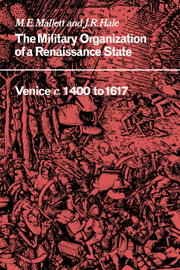Book contents
- Frontmatter
- Contents
- List of illustrations
- Acknowledgements
- References and abbreviations
- Map 1 The Terraferma in the fifteenth and sixteenth centuries
- Map 2 The empire da Mar
- PART I c. 1400 to 1508
- PART II 1509–1617
- 8 The historical role of the land forces 1509–1617
- 9 The wars
- 10 Government: policy, control and administration
- 11 The higher command
- 12 Manpower
- 13 Cavalry, infantry, artillery
- 14 Fortifications in the Terraferma
- 15 The defence of the maritime empire
- 16 The costs of defence and war
- Conclusion: the European context 1525–1617
- Appendix Infantry wages in the sixteenth century
- Select bibliography
- Index
10 - Government: policy, control and administration
Published online by Cambridge University Press: 22 October 2009
- Frontmatter
- Contents
- List of illustrations
- Acknowledgements
- References and abbreviations
- Map 1 The Terraferma in the fifteenth and sixteenth centuries
- Map 2 The empire da Mar
- PART I c. 1400 to 1508
- PART II 1509–1617
- 8 The historical role of the land forces 1509–1617
- 9 The wars
- 10 Government: policy, control and administration
- 11 The higher command
- 12 Manpower
- 13 Cavalry, infantry, artillery
- 14 Fortifications in the Terraferma
- 15 The defence of the maritime empire
- 16 The costs of defence and war
- Conclusion: the European context 1525–1617
- Appendix Infantry wages in the sixteenth century
- Select bibliography
- Index
Summary
The acuteness of the danger facing the republic in the years following Agnadello and the unprecedented series of campaigns that occupied the years before 1530 led to a method of running military affairs that, while drawing much from the past, established a pattern reused with only minor modification later in the century.
In spite of the need to make urgent decisions doges were granted no emergency powers; they remained symbols of the accumulated experience and current purpose of the state. As such, though of the multitude of letters addressed to them they were allowed to open none unless in the presence of their councillors, a letter, or a phrase in a letter from them, was a potent source of encouragement. Writing from his direction of the siege of Marano in 1514, Girolamo Savorgnan referred to one of his captains, Bernardino da Parma, who had been wounded. ‘And because he has borne himself worthily in this campaign I beg Your Serenity to be gracious enough to include in a letter to me a word or two of praise for him so that he will see that I have spoken well of him. And I will show this sentence to his companions, who will derive the greatest satisfaction from it.’ It was as a symbol that Doge Leonardo Loredan was repeatedly urged, and on two occasions reluctantly agreed, to send his sons to share the perils of towns threatened by siege on the mainland, and that the proposal was made in 1527 that Doge Andrea Gritti himself, rather than a proveditor-general, should join the main body of the army ‘because the King of France and the Sultan of Turkey go in person’.
- Type
- Chapter
- Information
- The Military Organisation of a Renaissance StateVenice c.1400 to 1617, pp. 248 - 283Publisher: Cambridge University PressPrint publication year: 1984



